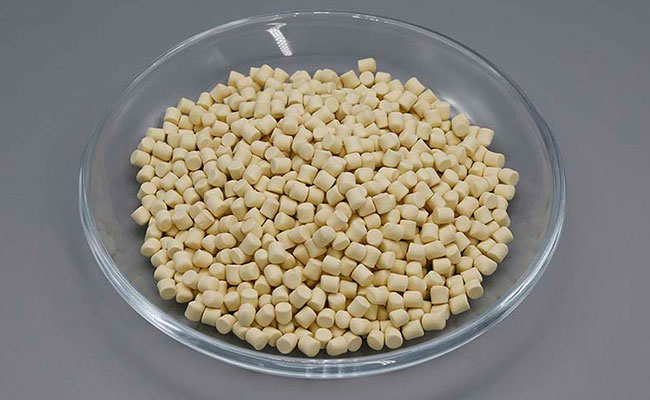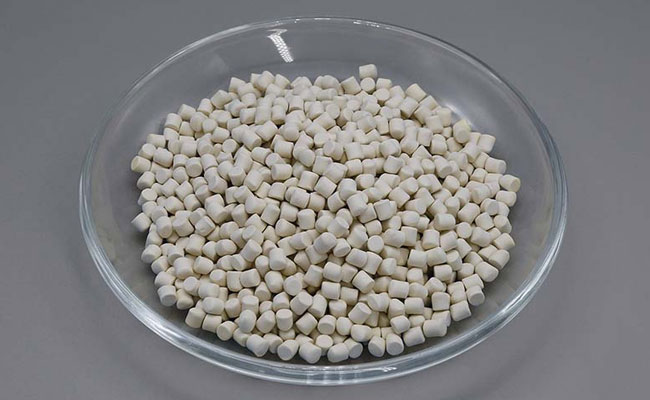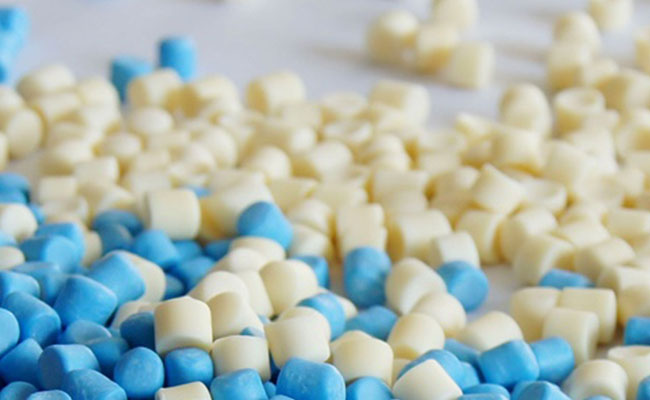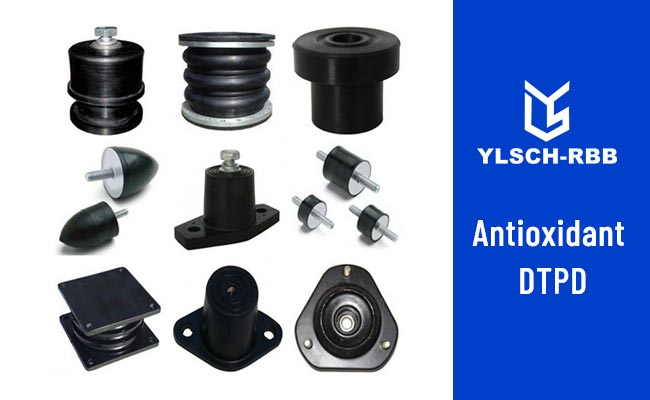
YLSCH-RBB® Rubber Vulcanizator Sulfur S-80
2023-06-09
YLSCH-RBB® Rubber Accelerator HEXA-80
2023-10-30Abstract: The effects of sulfur vulcanization system, peroxide vulcanization system and compound vulcanization system on the properties of EPDM rubber hose compounds were compared, and the EPDM rubber hose of BIPB/S/DTDM/CZ compound vulcanization system was studied by orthogonal experiment method. Compound properties. The results show that the comprehensive effect of the compound properties of EPDM rubber hose using BIPB/S/DTDM/CZ compound vulcanization system is better than that of sulfur vulcanization system and peroxide vulcanization system; the amount of BIPB is the main factor affecting the scorch time T10, The amount of S is the main factor affecting the compression set. The optimal ratio of BIPB/S/DTDM/CZ compound vulcanization system is 2.5 for BIPB, 0.3 for S, 1.2 for DTDM, and 0.9 for CZ.
As we all know, the main chain of EPDM rubber is completely saturated, which makes it have excellent heat aging resistance, weather resistance, ozone resistance, chemical resistance and electrical insulation performance. It is widely used, mainly used in rubber hoses, sealing strips and other products in automotive parts [1~2]. EPDM rubber can be vulcanized by common sulfur vulcanization system, sulfur donor vulcanization system, peroxide vulcanization system, reactive resin vulcanization system, etc. [3~5]. Different vulcanization systems directly affect the vulcanization characteristics of the rubber compound and the physical and mechanical properties and heat aging resistance of the vulcanized rubber. Experiments have proved that the EPDM vulcanizate with the sulfur vulcanization system has good comprehensive mechanical properties, poor heat and oxygen aging resistance and compression set resistance, and the EPDM vulcanizate with the peroxide vulcanization system has good heat and oxygen aging resistance and compression set resistance, and poor tear resistance and other properties. Therefore, this paper compares the effects of sulfur vulcanization system, peroxide vulcanization system, and composite vulcanization system on the properties of EPDM rubber hose compounds, and uses the BIPB/S/DTDM/CZ composite vulcanization system to study the scorch time T10, tensile strength, elongation at break, and compression set of EPDM rubber hose compounds through orthogonal experiments. The ratio of the vulcanization system is optimized, and rubber hose compounds with excellent properties are obtained.
1 Experiment
1.1 Main raw materials
EPDM, carbon black, modified calcined clay, BIPB (odorless DCP),Anti-aging agent, nano calcium carbonate, paraffin oil, sulfur, accelerator DTDM, accelerator CZ, etc.
1.2 Main equipment and instruments
Internal mixer XSM-2, open mixer XK-160, 100 t electric heating plate vulcanizer, rubber rotorless vulcanizer, universal material tensile testing machine, thickness gauge, Shore hardness tester, rubber aging tester, compression set device.
1.3 Test formula
Basic formula (unit: part): EPDM 100, zinc oxide 5 stearic acid 1.5 anti-aging agent 1.5, nano calcium carbonate 25, paraffin oil 30, charcoal Black 50, 20 parts of modified calcined clay, see Table 1 for vulcanization system:
Table 1 Vulcanization systems
| Item | Sample No. | BIPB | S | DTDM | CZ |
| Sulfur vulcanization system | 1# | / | 2 | 0.9 | 1.2 |
| Peroxide vulcanization system | 2# | 2.5 | / | / | / |
| Composite vulcanization system | 3# | 2.5 | 0.3 | 0.9 | 0.9 |
1.4 Preparation process
Add EPDM to the mixer for 3 minutes, then add active agent and anti-aging agent, add 1/2 of the reinforcing filling system (carbon black, modified calcined clay, nano-calcium carbonate) after 2 minutes, and then add the remaining 1/2 of the reinforced filling system, plasticizer for mixing, and debinding at 125 °C. Add a vulcanization accelerator to the open mill, cut the knives left and right 3 times after eating the powder, make triangle bags 6 times, and then make large rolls 5 times, and finally unload and park for more than 16 hours. The vulcanization curve was measured by a vulcanizer and samples were prepared for related tests. The vulcanization condition of the vulcanizate was 170℃×t90.
1.5 Performance test
The vulcanization properties of the compound are tested in accordance with GB/T16584-1996, the test condition is 170 ℃ × 30min, the Shore A hardness is tested in accordance with GB/T 531.1-2008, the tensile properties are tested in accordance with GB/T 528-2009, heat-resistant air aging The performance is tested according to GB/T 3512-2014, the test condition is 110 ℃ × 72 h, the compression set performance is tested according to GB/T7759.1-2015, the test condition is 110℃×24 h.
2 Results and discussion
2.1 Effect of different vulcanization systems on the properties of EPDM rubber hose compounds
Table 2 Performance of three different vulcanization systems on EPDM rubber hose compounds
| Sample No. | 1# | 2# | 3# |
| T10 /min | 2.533 | 1.267 | 2.883 |
| T90 /min | 12.75 | 16.033 | 17.625 |
| Tensile strength/MPa | 15.9 | 12.3 | 14.6 |
| Elongation at break /% | 397 | 449 | 485 |
| Shore A hardness/degree | 70 | 65 | 68 |
| Compression set /% | 26 | 21 | 18 |
| Hot air aging (110 ℃ × 72 h) | |||
| Tensile strength change rate /% | +5 | +10 | +8 |
| Change rate of elongation at break /% | -8 | +6 | +2 |
| Shore A hardness change/degree | +8 | +4 | +5 |
Table 2 shows the performance of three different vulcanization systems of sulfur vulcanization system, peroxide vulcanization system and composite vulcanization system on EPDM rubber hose compounds. The sulfur vulcanization system produces polysulfide cross-links, and under the effect of high temperature and long-term aging, the cross-links will be broken. For compression permanent deformation, after the cross-links are broken, the stress will relax, and the molecular chain will be displaced. The rate of change after hot air aging and compression deformation is small. At the same time, it can be seen from Table 2 that the scorch time T10 of the EPDM rubber hose compound using the compound vulcanization system is in the middle position, indicating that the crosslinking agent has a certain delay effect on the scorch time T10 and improves the operation safety. The sulfur vulcanization system has the highest tensile strength, followed by the composite vulcanization system, the lowest peroxide vulcanization system, the highest elongation at break composite vulcanization system, the smallest compression set vulcanization system, the best hot air aging performance composite vulcanization system, the second is the peroxide vulcanization system, and the third is the sulfur vulcanization system. Based on the above properties, the composite vulcanization system is preferred for EPDM rubber hose compound.
2.2 Design of Orthogonal Experiment
2.2.1 The characteristics and selection of orthogonal tables
When carrying out multi-factor and multi-level experiments, the advantages of choosing the orthogonal test method are: ①Uniform dispersion, that is, the experimental conditions are scattered in the combination of complete levels, which is highly representative; ②Overall comparability, that is, for each column of factors, the number of occurrences of other factors in each level is the same in the sum of each level, and the interference of other factors is excluded to the greatest extent, so that reasonable conclusions can be drawn [6~7].
2.2.2 Determination of experimental factors and levels
In this paper, BIPB, S, DTDM, and CZ are used as four factors, and each factor takes three appropriate levels to carry out an orthogonal experimental design. The design of factors and levels of this experiment is shown in Table 3.
Table 3 Experimental factors and levels
| Factor | ||||
| Level | A | B | C | D |
| BIPB | S | DTDM | CZ | |
| 1 | 2.0 | 0.9 | 0.6 | 1.2 |
| 2 | 2.5 | 0.6 | 0.9 | 0.9 |
| 3 | 3.0 | 0.3 | 1.2 | 0.6 |
2.2.3 Orthogonal experiment table and experimental data
Since there are 4 factors to be investigated, there are correspondingly 3 levels, ignoring the interaction between each factor, the obtained orthogonal table should be 4 factors and 3 levels, and the corresponding orthogonal table header is L9(34). A total of 9 experiments were conducted and tested in three batches. The L9(34) orthogonal table and its corresponding experimental data are shown in Table 4, and the analysis of the experimental results is shown in Table 5 to Table 8.
Table 4 L9 (34) Orthogonal Experiment Checklist and Experimental Results
| Test No. | Factor Column | Vulcanization Properties | Mechanical Properties | Compression Permanent Deformation /% | ||||
| A | B | C | D | T10/min | Tensile strength/MPa | Elongation at break /% | ||
| L1 | 1 | 1 | 1 | 1 | 3,148 | 12.7 | 485 | 45 |
| L2 | 1 | 2 | 2 | 2 | 3,092 | 13.2 | 520 | 36 |
| L3 | 1 | 3 | 3 | 3 | 2,878 | 13.5 | 545 | 24 |
| L4 | 2 | 1 | 2 | 3 | 2,312 | 12.8 | 536 | 35 |
| L5 | 2 | 2 | 3 | 1 | 2.725 | 13.5 | 484 | 30 |
| L6 | 2 | 3 | 1 | 2 | 2,480 | 14.1 | 500 | 24 |
| L7 | 3 | 1 | 3 | 2 | 2,527 | 14.8 | 509 | 26 |
| L8 | 3 | 2 | 1 | 3 | 2,060 | 14.2 | 482 | 22 |
| L9 | 3 | 3 | 2 | 1 | 1.892 | 13 | 435 | 16 |
Table 5 Range analysis of test results of scorch time T10
| Factor | T10/min | |||
| A | B | C | D | |
| Mean 1 | 3.039 | 2.662 | 2.563 | 2.588 |
| Mean 2 | 2.506 | 2.626 | 2.432 | 2.700 |
| Mean 3 | 2.160 | 2.417 | 2.710 | 2.417 |
| R (extremely poor) | 0.879 | 0.245 | 0.278 | 0.283 |
Table 6 Range analysis of tensile strength test results
| Factor | Tensile strength /MPa | |||
| A | B | C | D | |
| Mean 1 | 13.133 | 13.433 | 13.667 | 13.067 |
| Mean 2 | 13.467 | 13.633 | 13.000 | 14.033 |
| Mean 3 | 14.000 | 13.533 | 13.933 | 13.500 |
| R (extremely poor) | 0.867 | 0.200 | 0.933 | 0.966 |
Table 7. Range analysis of experimental results of elongation at break
| Factor | Elongation at break /% | |||
| A | B | C | D | |
| Mean 1 | 516.667 | 510.000 | 489.000 | 468.000 |
| Mean 2 | 506.667 | 495.333 | 497.000 | 509.667 |
| Mean 3 | 475.333 | 493.333 | 512.667 | 521.000 |
| R (extremely poor) | 41.334 | 16.667 | 23.667 | 53.000 |
Table 8. Range analysis of compression set test results
| Factor | Compression set /% | |||
| A | B | C | D | |
| Mean 1 | 35.000 | 35.333 | 30.333 | 30.333 |
| Mean 2 | 29.667 | 29.333 | 29.000 | 28.667 |
| Mean 3 | 21.333 | 21.333 | 26.667 | 27.000 |
| R (extremely poor) | 13.667 | 14.000 | 3.666 | 3.333 |
2.2.4 Orthogonal test results analysis
This paper mainly studies the scorch time T10, tensile strength, elongation at break and compression set of EPDM rubber hose compound. For the above four properties, the primary and secondary order can be ranked according to the size of the range from Table 5 to Table 8. T10 is A>D>C>B, tensile strength is D>C>A>B, and elongation at break is D> A>C>B, compression set is B>A>C>D.
In the formula design of EPDM rubber hose compound orthogonal experiment, the tensile strength is the most important performance, factor A is in the third place in the tensile strength, you can choose A2 or A3, and the scorch time T10 is in the most important position, can choose A1 or A2, which ranks second in elongation at break and compression set. can choose A1 or A2 for elongation at break, and you can choose A2 or A3 for compression set. In summary Consideration A should choose A2. Factor B is in the least important position in scorch time T10, tensile strength and elongation at break, and is in the most important position in compression set, so choose B3. Factor C ranks second in tensile strength, can choose C2 or C3, and ranks third in scorch time T10, elongation at break, and compression set, and can choose C2 or C3. In summary, consider factor C C3 is optional. Factor D is in the most important position in tensile strength and elongation at break, you can choose D2 or D3, it is in the secondary position in scorch time T10, you can choose D1 or D2, and it is in the least important position in compression set , considering the above factors D can choose D2.
In summary, the optimal ratio of EPDM rubber hose compound vulcanization system is A2B3C3D2, that is, the amount of BIPB in the basic formula is 2.5, the amount of S is 0.3, the amount of DTDM is 1.2, and the amount of CZ is 0.9.
3 Conclusion
(1) The comprehensive effect of EPDM rubber hose compound properties using BIPB/S/DTDM/CZ compound vulcanization system is better than that of sulfur vulcanization system and peroxide vulcanization system.
(2) The results and analysis of orthogonal experiments show that the amount of BIPB is the main factor affecting the scorch time T10, and the amount of S is the main factor affecting the compression set.
(3) Through the results and analysis of the orthogonal test, within the value range of each factor level, the optimal ratio of the compound vulcanization system for EPDM rubber hose compound is 2.5 for BIPB, 0.3 for S, 1.2 for DTDM, and 1.2 for CZ 0.9.
Our factory is the largest enterprise producing DTDM in China, please feel free to consult about the use and formulation of DTDM~
At the same time, it also produces DCBS, NOBS (the raw material is acid-base MBT), and the production of polymer masterbatches. Please feel free to contact me if you have any questions~




